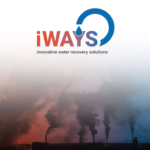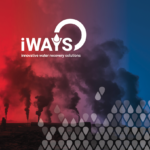Institutional Presentation
Policy Briefs
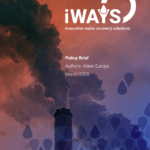
Policy Brief March 2023
Innovative & Impactful Approach for a Water-Smart Industrial Emissions Directive
Scientific Publications

Parametric investigation on a serpentine condensing heat exchanger
139 Parametric investigation on a serpentine condensing heat exchanger Mohab Salem*, Robertas Poškas Lithuanian Energy Institute, Kaunas, Lithuania https://doi.org/10.21175/rad.abstr.book.2024.30.1 The utilization of waste heat in industrial settings plays a crucial role in maximizing production efficiency and adheres to the principles of the circular economy. Repurposing waste heat enhances resource efficiency and mitigates environmental impact. The European Union actively advocates for the transition to efficient technologies to minimize waste heat generation, thereby reducing energy costs and maintaining competitiveness in the market. Improved energy efficiency not only decreases pollution but also aligns with environmental imperatives. Lithuania's energy strategy places significant emphasis on objectives pertaining to electricity, heating, and energy efficiency, with a specific focus on promoting energy generation from waste sources. These endeavors contribute to both economic prosperity and environmental sustainability. EU Horizon 2020 projects such as The Innovative WAter recoverY Solutions through recycling of heat, materials, and water across multiple sectors (iWAYS) further enhance waste heat recovery processes in industrial applications.

Modelling of flow and convective heat transfer in serpentine heat exchanger (Abstract)
Condensing heat exchangers play a key role in the waste heat recovery process, which can be of various designs depending on the primary heat source, its pollution level, the place where the heat exchanger needs to be installed, etc. In order to be able to evaluate various influencing parameters, it is most appropriate to use numerical simulation, which can be used to quickly evaluate the efficiency of a heat exchanger of a specific design in the case of different flow regimes. It is the most difficult to model the condensation process, because in this case two phases appear, the interaction of which requires a lot of theoretical and practical knowledge. In order to be able to analyze the interaction of two-phase flows, it is necessary to approach this task step by step, starting from the analysis of single- phase flow to understand the physical processes taking place in the heat exchanger, which usually contains variously arranged tube bundles of different shapes. Therefore, in this paper, numerical studies of hydrodynamics and convective heat transfer were performed to better understand the fluid behavior in a serpentine type condensing heat exchanger.
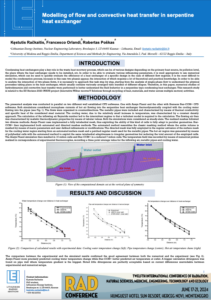
Modelling of flow and convective heat transfer in serpentine heat exchanger (Poster)
Condensing heat exchangers play a key role in the waste heat recovery process, which can be of various designs depending on the primary heat source, its pollution level, the place where the heat exchanger needs to be installed, etc. In order to be able to evaluate various influencing parameters, it is most appropriate to use numerical simulation, which can be used to quickly evaluate the efficiency of a heat exchanger of a specific design in the case of different flow regimes. It is the most difficult to model the condensation process, because in this case two phases appear, the interaction of which requires a lot of theoretical and practical knowledge. In order to be able to analyze the interaction of two-phase flows, it is necessary to approach this task step by step, starting from the analysis of single-phase flow to understand the physical processes taking place in the heat exchanger, which usually contains variously arranged tube bundles of different shapes. Therefore, in this paper, numerical studies of hydrodynamics and convective heat transfer were performed to better understand the fluid behavior in a serpentine type condensing heat exchanger. This research study is related to the EU Horizon 2020 iWAYS project (Innovative WAter recoverY Solutions through recycling of heat, materials, and water across multiple sectors) activities.

A CFD Study on Different Configurations of Spacer-Filled Membrane Distillation System Using OpenFOAM
Circular economy initiatives like the EC funded iWAYS project (grant agreement: 958274) promote the reuse of waste heat in industrial sites. This presents opportunities and challenges for technological adaptation. Membrane distillation (MD) is a thermally driven process for water treatment that can use waste heat. However, effectively treating complex industrial wastewater requires adapting MD units to achieve reliable and efficient performance. Filament spacers within the MD units play a key role in structural maintenance and flow mixing. CFD simulations can help to characterize filament spacer configuration impacts on the hydrodynamic of feed and permeate channels, which affects both trans-membrane temperature gradient and membrane fouling control. Here, we performed a CFD study on a direct contact membrane distillation (DCMD) sub-unit with the goal of evaluating impact on robustness and performance of a set of designed filament spacer configurations. The modeled membrane distillation system has an overall length of 200 mm, width of 10 mm and height of 4.1 mm, containing two layers of filaments in each of the feed and permeate channels. The diameter of the filaments was 1 mm, and they had a 45◦ degree angle to the flow direction in the channels. Variations of this standard filament configuration were also tested and simulated to optimize their mixing performance. The numerical simulations to approximate in a 3D solution of Navier-stokes equations for steady state conditions were performed using OpenFOAM code. The computational domains were meshed using OpenFOAM snappyHexMesh utility, and finite-volume based simulation relying on the chtMultiRegionFoam solver was executed in parallel over 40 CPU cores. Comparing the CFD analysis of different filaments´ configurations lead to an assessment of an improved spacer structure. The selected configuration is to be 3D printed for laboratory-scale experimental confirmation of the validity of the CFD model and the optimal configuration finding.

Experimental investigation of humidified air condensation in different rows of serpantine heat exchanger – Cooling water flow rate effect
Condensing economizers are used in the industry as they enable the acquisition of additional heat during vapor condensation. In condensing heat exchangers, water is the usual cooling agent due to its high specific heat capacity and thus efficient heat removal. Therefore, experiments of hot humid air condensation in a serpentine economizer being cooled by water were performed to reveal the effect the cooling water flow rate has on humidified air condensation in separate rows of the serpentine type economizer (with vertical tubes). The results have shown that the cooling ratio (mass flow ratio between the coolant and the humid air) had a minor effect on the distribution of the humidified air temperature along test section for inlet Reynolds number of 3000–10000. The effects on the condensation flux distribution in different rows were much stronger. The most optimal cooling ratio was determined to be 3. The results have shown that the biggest condensation efficiency is up to 35 %. It was revealed that in some cases the convection was prevailing in the first rows of the economizer and this resulted in a decreased efficiency/performance of the exchanger. The obtained results from the practical point of view will provide an extended basis for the optimisation of the design of economizers for waste heat recovery in the cases of different cooling water flow rates. It could also be applied to validate computational models developed for condensation heat transfer and condensate flux numerical modelling along economizer.
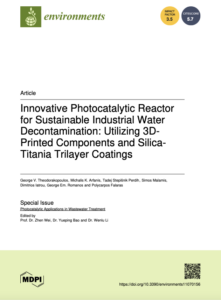
Innovative Photocatalytic Reactor for Sustainable Industrial Water Decontamination: Utilizing 3D-Printed Components and Silica-Titania Trilayer Coatings
Industrial activities generate enormous quantities of polluted effluents, necessitating advanced methods of wastewater treatment to prevent potential environmental threats. Thus, the design of a novel photocatalytic reactor for industrial water decontamination, purification, and reuse is proposed as an efficient advanced oxidation technology. In this work, the development of the active reactor components is described, utilizing a two-step sol–gel technique to prepare a silica-titania trilayer coating on 3D-printed polymeric filters. The initial dip-coated SiO2 insulator further protects and enhances the stability of the polymer matrix, and the subsequent TiO2 layers endow the composite architecture with photocatalytic functionality. The structural and morphological characteristics of the modified photocatalytic filters are extensively investigated, and their performance is assessed by studying the photocatalytic degradation of the Triton X-100, a common and standard chemical surfactant, presented in the contaminated wastewater of the steel metal industry. The promising outcomes of the innovative versatile reactor pave the way for developing scalable, cost-effective reactors for efficient water treatment technologies.
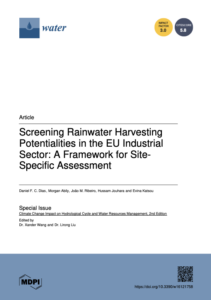
Screening Rainwater Harvesting Potentialities in the EU Industrial Sector: A Framework for Site-Specific Assessment
The industrial sector’s water consumption is projected to increase by 400% by 2050, placing significant stress on freshwater reserves. To address this challenge, innovative solutions for water management are crucial. This paper proposes a comprehensive framework for Rainwater Harvesting (RWH) in industrial settings, offering a methodology to assess the potential for RWH implementation across EU industrial sites. The framework integrates internal and publicly available datasets, including EU climate change monthly average rainfall data from the Copernicus Climate Data Store, to create current and prospective scenarios for RWH. The methodology evaluates critical parameters co-created with industrial stakeholders, such as catchment area, water quality, and industrial water requirements. This approach allows for site-specific assessments, enabling industries to reduce freshwater consumption and support sustainability goals within the Horizon 2050 framework. Our findings indicate that implementing RWH systems can significantly contribute to a sustainable and circular economy by reducing annual freshwater consumption, promoting resource reuse, and lowering industrial water costs. This framework provides industries with a tool to assess RWH feasibility, supporting their efforts to prepare for increased water demands and contribute to environmental conservation.
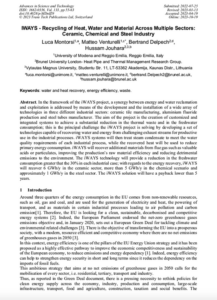
IWAYS - Recycling of Heat, Water and Material across Multiple Sectors: Ceramic, Chemical and Steel Industry
In the framework of the iWAYS project, a synergy between energy and water reclamation and exploitation is addressed by means of the development and the installation of a wide array of technologies in three different industrial sectors: ceramic tile manufacturing, aluminium fluoride production and steel tubes manufacturer. The aim of the project is the creation of customized and integrated systems to achieve a substantial reduction in the thermal waste and in the freshwater consumption; this is the principal challenge the iWAYS project is solving by developing a set of technologies capable of recovering water and energy from challenging exhaust streams for productive use in the industrial processes. iWAYS systems will then treat steam condensate to meet the water quality requirements of each industrial process, while the recovered heat will be used to reduce primary energy consumption. iWAYS will recover additional materials from flue gas such as valuable acids or particulates, improving the production’s raw material efficiency and reducing detrimental emissions to the environment. The iWAYS technology will provide a reduction in the freshwater consumption greater that the 30% in each industrial case; with regards to the energy recovery, iWAYS will recover 6 GWh/y in the ceramic sector, more than 5 GWh/y in the chemical scenario and approximately 1 GWh/y in the steel sector. The iWAYS solution will have a payback lower than 5 years.
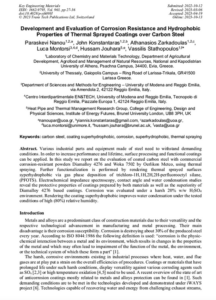
Development and Evaluation of Corrosion Resistance and Hydrophobic Properties of Thermal Sprayed Coatings over Carbon Steel
IVarious industrial parts and equipment made of steel need to withstand demanding conditions. In order to increase performance and lifetime, surface processing and functional coatings can be applied. In this study we report on the evaluation of coated carbon steel with commercial corrosion-resistant powders Diamalloy 4276 and Woka 7502 by Oerlikon Metco, using thermal spraying. Further functionalization is performed by rendering thermal sprayed surfaces syperhydrophobic via gas phase deposition of trichloro-1H,1H,2H,2H-perfluorooctyl silane, (PFOTS). Electrochemical impedance spectroscopy, contact angle and water condensation studies reveal the protective properties of coatings prepared by both materials as well as the superiority of Diamalloy 4276 based coatings. Corrosion was evaluated under a harsh 20% w/w H 2 SO 4 environment. Rendering the coating superhydrophobic improves water condensation under the tested conditions of high (80%) relative humidity.
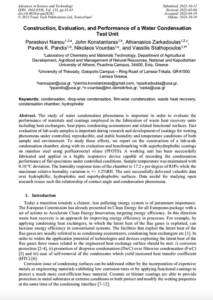
Construction, Evaluation, and Performance of a Water Condensation Test Unit
The study of water condensation phenomena is important in order to evaluate the performance of materials and coatings employed in the fabrication of waste heat recovery units including heat exchangers, heat pipes, condensing economizers and related functional surfaces. Fast evaluation of lab-scale samples is important during research and development of coatings for wetting phenomena under controlled, reproducible, and stable humidity and temperature conditions of both sample and environment. To study these effects, we report on the construction of a lab-scale condensation chamber, along with its evaluation and benchmarking with superhydrophobic coatings on stainless steel using perfluorooctyl silane (PFOTS). A working unit has been successfully fabricated and applied in a highly responsive device capable of recording the condensation performance of flat specimens under controlled conditions. Sample temperature was maintained with 0.10 °C deviation. The humidity response time of the chamber is 17.2 s per degree of RH% while the maximum relative humidity variation is +/- 3.2%RH. The unit successfully delivered valuable data over hydrophillic, hydrophobic and superhydrophobic surfaces. Data useful for studying open research issues such the relationship of contact angle and condensation phenomena.
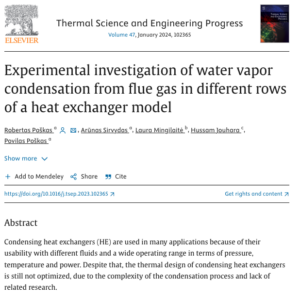
Experimental investigation of water vapor condensation from flue gas in different rows of a heat exchanger model
Condensing heat exchangers (HE) are used in many applications because of their usability with different fluids and a wide operating range in terms of pressure, temperature and power. Despite that, the thermal design of condensing heat exchangers is still not optimized, due to the complexity of the condensation process and lack of related research. This paper presents results of experimental investigations of biofuel flue gas water vapor condensation on vertical tubes in different rows of a tube bundle in a crossflow. The effects of water vapor mass fraction, inlet flue gas temperature and the Reynolds number on heat transfer when the inlet cooling water temperature and flow rate are constant were analyzed. The results obtained showed that the main parameters which had the most influence on the condensation process were the water vapor mass fraction in the flue gas and its temperature at the inlet to the test section. In the range of inlet flue gas Reynolds numbers investigated, the Re effect on heat transfer was not as significant as the effect of the parameters indicated above. However, the Re number had some influence on the heat transfer variation along the inline tube bundle. A comparison of the average Nu number in the case of dry air with the experimentally determined average Nu number, even with low condensable gas mass fraction (6 %), showed that it increased considerably. A correlation was proposed, which helps to determine the average Nu number for the heat exchanger in the range of experiments performed.
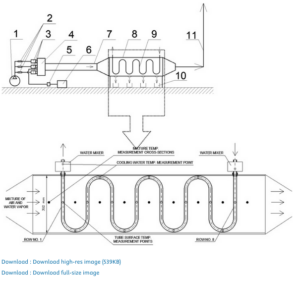
Experimental investigation of water vapor condensation from hot humidified air in serpentine heat exchanger
Condensing economizers are used in industry and power plants for waste heat recovery. Despite widespread use, their thermal design is still not optimized due to the complexity of the condensation process especially when non-condensing gasses are prevalent. This paper presents an experimental study of water vapor condensation on the vertical tubes of a serpentine bundle in a humidified air crossflow at water vapor mass fractions of 10% and 20%. The analysis showed a clear dependence of the efficiency of the condensation process on the humidified air inlet temperature and Reynolds number, and the efficiency increases as these parameters decrease. Condensation efficiency also depends highly on flow humidity especially in the region of higher Reynolds numbers. A comparison of the average Nusselt number in the case of dry air with the experimentally determined average Nusselt number is also presented, and showed a uniform increase in the Nusselt number as the inlet temperature of the humidified air decreased.
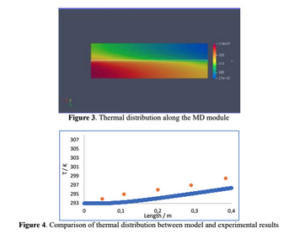
CFD analysis for membrane distillation optimization for wastewater treatment
In the context of circular economy and of decarbonisation of the society, one of the uprising techniques for industrial wastewater treatment is the use of Membrane distillation (MD) system, because of its capabilities such as low carbon footprint, and being able to be coupled with waste thermal energies. However, the main drawback of these systems is the temperature polarization phenomenon which can lead to performance reduction. To overcome this problem, geometry modifications such as adding spacers in the system is considered. Thus, a simple geometry is built to study the thermal distribution through the system, and then the effects of adding spacers with different configurations is here investigated using Computational Fluid Dynamics (CFD) analysis. The different spacer configurations are characterised and their effect on MD performance are tested. The optimal configuration will be used, via 3D printing to confirm finding on an experimental setup on upcoming study. To read conference proceedings of ECO STP Conference 2023, p. 208, click on image to the left.
